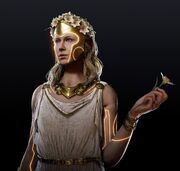Sadelyrate (talk | contribs) No edit summary |
Sadelyrate (talk | contribs) No edit summary |
||
| (12 intermediate revisions by 6 users not shown) | |||
| Line 1: | Line 1: | ||
{{Era|Individuals|Isu}} |
{{Era|Individuals|Isu}} |
||
{{WP-REAL}} |
{{WP-REAL}} |
||
| + | {{Youmay|the Greek goddess|the [[Kore|wife]] of Leiandros}} |
||
| − | {{Spoilerhd|23 July 2019}} |
||
| − | {{Youmay|the daughter of the goddess Demeter, Persephone|[[Kore]], a 5th century BCE Pephkan}} |
||
{{Update|[[The Fate of Atlantis: Fields of Elysium]]}} |
{{Update|[[The Fate of Atlantis: Fields of Elysium]]}} |
||
{{Stub}} |
{{Stub}} |
||
{{Character Infobox |
{{Character Infobox |
||
| + | | name = Persephone |
||
| ⚫ | |||
| + | | image = ACOd-TFoA_-_Persephone_render.png |
||
| − | |active = [[Isu Era]] |
||
| − | | |
+ | | active = [[Isu Era]] |
| − | | |
+ | | species = [[Isu]] |
| + | | affiliates = [[Sister Realms]] |
||
| − | }} |
||
| + | *[[Elysium]] |
||
| ⚫ | |||
| + | | voice = [[Kate Drummond]]}} |
||
| ⚫ | |||
| − | The daughter of [[Demeter]] and [[Zeus]], and the wife of [[Hades]], Persephone ruled the realm of [[Elysium]] alongside her friend [[Hekate]].<ref>''[[Assassin's Creed: Odyssey]]'' – ''[[The Fate of Atlantis: |
+ | The daughter of [[Demeter]] and [[Zeus]], and the wife of [[Hades]], Persephone ruled the realm of [[Elysium]] alongside her friend [[Hekate]].<ref>''[[Assassin's Creed: Odyssey]]'' – ''[[The Fate of Atlantis: Fields of Elysium]]''</ref> |
==Biography== |
==Biography== |
||
| + | ===Mythology=== |
||
| ⚫ | |||
| + | In time, Persephone and other Isu came to be revered in the Greek pantheon as gods and goddesses. |
||
| + | |||
| ⚫ | |||
| + | |||
| + | ===Simulation=== |
||
| + | During the 5th century BCE, Persephone and Elysium were recreated from the memories of the Isu [[Aletheia]] in order for the [[Sparta]]n ''[[Mercenary|misthios]]'' [[Kassandra]] to master the [[Staff of Hermes Trismegistus]]. Upon meeting Kassandra, the simulant Persephone reacted to the intrusion into her realm, telling the ''misthios'' that she did not belong, but otherwise left her be.<ref>''Assassin's Creed: Odyssey'' – ''The Fate of Atlantis: Fields of Elysium'' – [[Welcome to Elysium]]</ref> |
||
==Legacy and influence== |
==Legacy and influence== |
||
| − | The [[Sanctuary of Eleusis]] within the [[Sacred Plains of Demeter]] in [[Attika]] was a central location for the worship of Persephone and Demeter, and in the [[Eleusis Telesterion|Telesterion]] people annually participated in the |
+ | The [[Sanctuary of Eleusis]] within the [[Sacred Plains of Demeter]] in [[Attika]] was a central location for the worship of Persephone and Demeter,<ref>''Assassin's Creed: Odyssey'' – Attika: Sanctuary of Eleusis</ref> and in the [[Eleusis Telesterion|Telesterion]] people annually participated in the [[Eleusinian Mysteries]], initiation practices into their cult.<ref>''Assassin's Creed: Odyssey'' – Attika: Eleusis Telesterion</ref> In [[Athens]], a |
| − | [[Statue of Demeter and Kore|statue]] featuring Persephone and her mother stood watch over the [[Sacred Way|road]] leading from the [[Akropolis Sanctuary|acropolis]] to the Sanctuary of Eleusis.<ref |
+ | [[Statue of Demeter and Kore|statue]] featuring Persephone and her mother stood watch over the [[Sacred Way, Attika|road]] leading from the [[Akropolis Sanctuary|acropolis]] to the Sanctuary of Eleusis.<ref>''Assassin's Creed: Odyssey'' – Attika: Statue of Demeter and Kore</ref> |
| + | After imbibing [[lotus]] flower wine, [[Barnabas]] had three visions concerning his wife [[Leda (Barnabas' wife)|Leda]]. In one of these, he swore that Persephone led him [[Tomb of Polybotes|where]] mythical [[Siren (mythology)|sirens]] dwelled.<ref>''Assassin's Creed: Odyssey'' – [[Odyssey Into the Past]]</ref> |
||
| − | ==Trivia== |
||
| + | |||
| − | *[https://en.wiktionary.org/wiki/%CE%BA%CF%8C%CF%81%CE%B7 Κόρη] (''kórē'') is a Greek word meaning 'maiden, girl, bride'. |
||
| + | ==Behind the scenes== |
||
| − | + | Persephone's names are based on Greek: [https://en.wiktionary.org/wiki/%CE%BA%CF%8C%CF%81%CE%B7 Κόρη] (''kórē'') means 'maiden, girl, bride', while 'Persephone' may be related to the words [https://en.wiktionary.org/wiki/πέρθω πέρθω] (''pérthō''), meaning 'to destroy', and [https://en.wiktionary.org/wiki/φόνος φόνος] (''phónos''), meaning 'murder'. |
|
| ⚫ | |||
| + | |||
| ⚫ | |||
| + | |||
| + | The statue representing Persephone as Kore especially in Attika and Sanctuary of Eleusis in ''[[Assassin's Creed: Odyssey]]'' is based on the restored {{Wiki|Phrasikleia Kore}}, made by Aristion of Paros in 6th century BCE. |
||
==Gallery== |
==Gallery== |
||
| Line 31: | Line 42: | ||
Athens-KoreDemeter.jpg|The statue of Kore and Demeter in Athens |
Athens-KoreDemeter.jpg|The statue of Kore and Demeter in Athens |
||
ACOD_FoE_Persephone.jpg|Persephone on her throne in Elysium |
ACOD_FoE_Persephone.jpg|Persephone on her throne in Elysium |
||
| ⚫ | |||
ACOd-TFoA-Persephonecrownless-StephanieChafe.jpg|Models of Persephone without her headgear |
ACOd-TFoA-Persephonecrownless-StephanieChafe.jpg|Models of Persephone without her headgear |
||
ACOd-mural-PersephoneHades.jpg|A 5th century BCE mural depicting Persephone and Hades |
ACOd-mural-PersephoneHades.jpg|A 5th century BCE mural depicting Persephone and Hades |
||
| Line 36: | Line 48: | ||
==Appearances== |
==Appearances== |
||
| − | *''[[Assassin's Creed: Odyssey]]'' {{c| |
+ | *''[[Assassin's Creed: Odyssey]]'' {{c|artwork only}} |
**''[[The Fate of Atlantis: Fields of Elysium]]'' {{C|simulation}} |
**''[[The Fate of Atlantis: Fields of Elysium]]'' {{C|simulation}} |
||
| Line 45: | Line 57: | ||
[[Category:Individuals]] |
[[Category:Individuals]] |
||
[[Category:Isu]] |
[[Category:Isu]] |
||
| ⚫ | |||
[[Category:Elysians]] |
[[Category:Elysians]] |
||
| ⚫ | |||
Revision as of 10:10, 19 February 2020
| This article is about the Greek goddess. You may be looking for the wife of Leiandros. |

|
Patience, brothers. Soon we will reveal the secrets of The Fate of Atlantis: Fields of Elysium. This article has been identified as being out of date. Please update the article to reflect recent releases and then remove this template once done. |
Persephone, also called Kore, was an Isu, revered as the Greek goddess of the underworld, springtime, flowers, and blooming.
The daughter of Demeter and Zeus, and the wife of Hades, Persephone ruled the realm of Elysium alongside her friend Hekate.[1]
Biography
Mythology
In time, Persephone and other Isu came to be revered in the Greek pantheon as gods and goddesses.
As the daughter of Demeter, Persephone was known simply as Kore. When Hades, the Greek god of the underworld, stole Persephone to marry her, she came to be known as Persephone.[2]
Simulation
During the 5th century BCE, Persephone and Elysium were recreated from the memories of the Isu Aletheia in order for the Spartan misthios Kassandra to master the Staff of Hermes Trismegistus. Upon meeting Kassandra, the simulant Persephone reacted to the intrusion into her realm, telling the misthios that she did not belong, but otherwise left her be.[3]
Legacy and influence
The Sanctuary of Eleusis within the Sacred Plains of Demeter in Attika was a central location for the worship of Persephone and Demeter,[4] and in the Telesterion people annually participated in the Eleusinian Mysteries, initiation practices into their cult.[5] In Athens, a statue featuring Persephone and her mother stood watch over the road leading from the acropolis to the Sanctuary of Eleusis.[6]
After imbibing lotus flower wine, Barnabas had three visions concerning his wife Leda. In one of these, he swore that Persephone led him where mythical sirens dwelled.[7]
Behind the scenes
Persephone's names are based on Greek: Κόρη (kórē) means 'maiden, girl, bride', while 'Persephone' may be related to the words πέρθω (pérthō), meaning 'to destroy', and φόνος (phónos), meaning 'murder'.
The headgear Persephone is seen in the simulation is based on the Attic helmet.
The statue representing Persephone as Kore especially in Attika and Sanctuary of Eleusis in Assassin's Creed: Odyssey is based on the restored Phrasikleia Kore, made by Aristion of Paros in 6th century BCE.
Gallery
Appearances
- Assassin's Creed: Odyssey (artwork only)
- The Fate of Atlantis: Fields of Elysium (simulation)
References
- ↑ Assassin's Creed: Odyssey – The Fate of Atlantis: Fields of Elysium
- ↑ Assassin's Creed: Odyssey – Attika: Entrance to the Underworld
- ↑ Assassin's Creed: Odyssey – The Fate of Atlantis: Fields of Elysium – Welcome to Elysium
- ↑ Assassin's Creed: Odyssey – Attika: Sanctuary of Eleusis
- ↑ Assassin's Creed: Odyssey – Attika: Eleusis Telesterion
- ↑ Assassin's Creed: Odyssey – Attika: Statue of Demeter and Kore
- ↑ Assassin's Creed: Odyssey – Odyssey Into the Past
| ||||||||||||||||||||||||||||||||||||||||||||||||||||||||||||||||||






